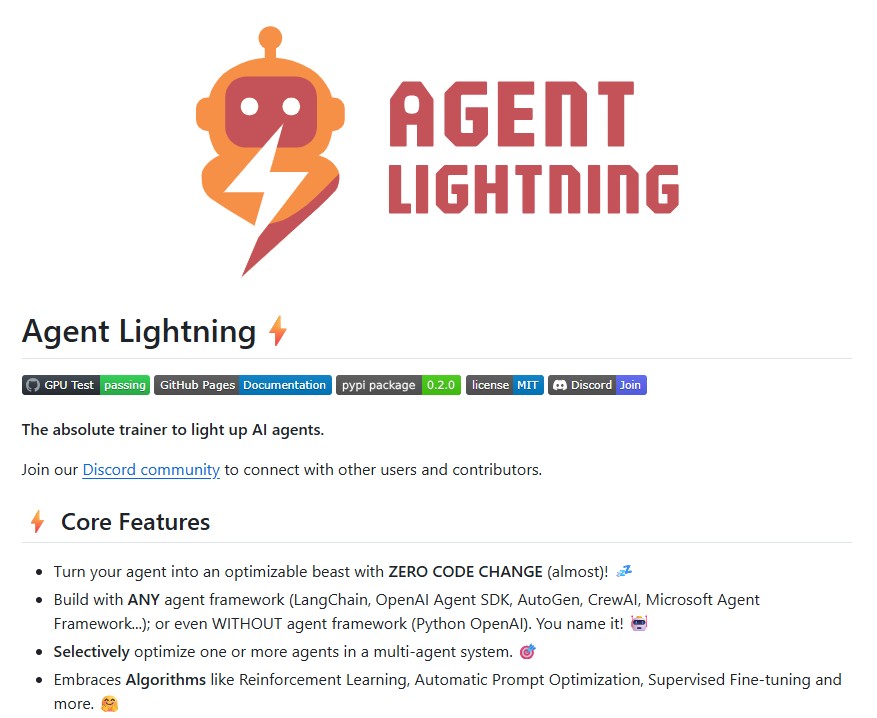Artificial Intelligence (AI) is rapidly moving from static models to intelligent agents capable of reasoning, adapting, and performing complex, real-world tasks. However, training these agents effectively remains a major challenge. Most frameworks today tightly couple the agent’s logic with training processes making it hard to scale or transfer across use cases.

Enter Agent Lightning, a breakthrough framework from Microsoft Research that enables reinforcement learning (RL)-based training for any AI agent with almost zero code modification. This innovation marks a significant leap in the evolution of AI agents bridging the gap between model training and real-world agent deployment.
What Is Agent Lightning?
Agent Lightning is an open-source, flexible, and extensible framework that allows developers to train large language model (LLM)-powered agents using reinforcement learning without being tied to any specific architecture, environment or codebase.
Unlike existing methods that fuse the agent’s training process with its core logic, Agent Lightning introduces a complete decoupling between agent execution and RL training. This design allows seamless integration with agents built using LangChain, OpenAI Agents SDK, AutoGen or even custom-built systems — all without rewriting code.
In simpler terms, Agent Lightning allows developers to take any AI agent whether it’s a chatbot, retrieval system, or code generator and make it learn from its own interactions using reinforcement learning.
The Problem with Traditional Agent Training
Modern AI agents rely on large language models that can reason, plan, and interact with tools or APIs. While this makes them powerful, it also introduces complexity. Traditional supervised learning methods require vast human-curated datasets that are expensive and limited in scope.
More importantly, these methods don’t allow agents to improve from real-world experience. For example, when an AI coding agent makes a mistake, that feedback isn’t automatically used to make the agent better over time. Reinforcement learning solves this problem by using reward signals — numerical scores representing success or failure allowing agents to learn through trial and error, much like humans do.
However, applying RL to real-world agents is difficult. Most frameworks are designed for single-turn interactions (like text completion) rather than multi-turn, tool-using or multi-agent scenarios. That’s where Agent Lightning comes in.
How Agent Lightning Works ?
Agent Lightning is built around two groundbreaking ideas:
1. Unified Data Interface
The framework introduces a unified data interface that transforms agent execution into a format compatible with RL training. Every time an agent performs an action such as generating text, calling a tool or retrieving data – Agent Lightning captures that step as a structured data unit (called a transition).
This allows reinforcement learning algorithms to analyze agent behaviors step-by-step, assign rewards and optimize performance – all without needing to understand the agent’s internal code.
2. Training-Agent Disaggregation Architecture
Agent Lightning’s system design separates the training process (Lightning Server) from the agent’s execution (Lightning Client).
- The Lightning Server manages RL training, updates the LLM, and provides an OpenAI-style API for the client.
- The Lightning Client runs the agent, collects interaction data, and sends it back to the server for training.
This architecture means you can connect any agent whether deployed locally or on the cloud to the training framework effortlessly.
LightningRL: The Engine Behind Agent Lightning
At the heart of this framework is LightningRL, a new hierarchical reinforcement learning algorithm designed specifically for AI agents.
Traditional RL methods treat each full agent interaction as a single event, which can be inefficient for complex workflows. LightningRL instead decomposes the agent’s trajectory into smaller steps such as queries, responses and tool calls and assigns “credit” to each step based on outcomes.
This granular feedback allows the system to train multi-step or multi-agent workflows efficiently enabling continuous and stable improvements over time.
Real-World Applications and Results
Microsoft Research validated Agent Lightning across diverse tasks and frameworks from SQL query generation to open-domain question answering.
- Text-to-SQL with LangChain:
Agent Lightning trained an AI to convert natural language into SQL queries. The model showed continuous performance improvement proving effective for multi-step workflows involving query generation and validation. - Retrieval-Augmented Generation (RAG) with OpenAI Agents SDK:
In RAG setups, the framework helped agents improve document retrieval and reasoning accuracy. By learning from rewards based on factual correctness and format, the agents showed measurable gains in understanding and answering complex, multi-hop questions. - Math Problem Solving with AutoGen:
In tool-augmented math tasks, Agent Lightning enabled LLMs to correctly decide when to use calculator tools improving both precision and reasoning.
Across all scenarios, Agent Lightning demonstrated stable and consistent reward growth, underscoring its effectiveness in training AI agents that can adapt and evolve in real-world contexts.
Why Agent Lightning Matters
Agent Lightning isn’t just another RL toolkit — it’s a unified foundation for the next generation of adaptive AI systems. Its innovations bring multiple advantages to developers and organizations:
- Agent-agnostic training: Works with any framework or environment.
- Zero-code modification: Integrates with existing agents seamlessly.
- Scalable system design: Supports distributed and parallel training.
- Automatic intermediate rewarding (AIR): Converts monitoring data into intermediate rewards for faster learning.
- Future-proof: Can extend beyond RL to other optimization methods like prompt tuning or self-correction.
By bridging reinforcement learning and agentic AI, Microsoft’s Agent Lightning sets the stage for self-improving AI systems where models continuously refine themselves based on real-world feedback.
Conclusion
As AI agents become central to automation, research, and enterprise solutions, the ability to train them efficiently and safely will define the next leap in artificial intelligence. Agent Lightning represents a major milestone in that journey merging reinforcement learning with flexible system design to create a framework that can train any AI agent anywhere.
With its open-source foundation, developer-friendly integration, and proven results, Agent Lightning is poised to accelerate the rise of intelligent, self-learning agents — a step closer to the true vision of adaptive, general-purpose AI.
Explore the project: GitHub – microsoft/agent-lightning
Read the full paper: arXiv:2508.03680v1
Follow us for cutting-edge updates in AI & explore the world of LLMs, deep learning, NLP and AI agents with us.
Related Reads
- Free for 1 Year: ChatGPT Go’s Big Move in India
- Reinforcement Learning for Large Language Models: A Complete Guide from Foundations to Frontiers Arun Shankar, AI Engineer at Google
- AI Projects : A Comprehensive Showcase of Machine Learning, Deep Learning and Generative AI
- LangExtract by Google: Transforming Unstructured Text into Structured Data with LLM Precision
- Qwen3-VL-8B-Instruct — The Next Generation of Vision-Language Intelligence by Qwen

4 thoughts on “Agent Lightning By Microsoft: Reinforcement Learning Framework to Train Any AI Agent”